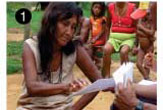Amazon Tribes Know Geometry

While high school freshmen sometimes struggle with parallelograms and the Pythagorean Theorem, people deep in the Amazon quickly grasp some basic concepts of geometry.
Although these indigenous tribes had never seen a protractor, compass, or even a ruler, a new study found they understood parallelism and right angles and can use distance, angles, and other relationships in maps to locate hidden objects.
The finding suggests all humans, regardless of language or schooling, possess a core set of geometrical intuitions.
"While geometrical concepts can be enriched by culture-specific devices like maps, or the terms of a natural language, underneath this variability lies a shared set of geometrical concepts," said study co-author Elizabeth Spelke of Harvard University. "Those concepts allow adults and children with no formal education, and minimal spatial language, to categorize geometrical forms and to use geometrical relationship to represent the surrounding spatial layout."
The study is detailed in the Jan. 20 issue of the journal Science.
Rainforest math class
Spelke and her colleagues developed and administered two sets of tests during two visits to the Munduruku people, who live in remote areas along the Cururu River in Brazil.
Get the world’s most fascinating discoveries delivered straight to your inbox.
They assessed comprehension of basic concepts such as points, lines, parallelism, figure congruence, and symmetry by presenting arrays of six images, one of which was subtly different from the rest.
For example, five similar trapezoids would be shown with a sixth non-trapezoidal quadrilateral of similar size and subjects were asked to point out which of the images was "weird" or "ugly."
Subjects as young as six years old pointed to the dissimilar image an average of 66.8 percent of the time, showing competence with basic concepts of topology, Euclidean geometry, and basic geometrical figures, researchers say.
"If the Munduruku share with us the conceptual primitives of geometry," the researchers write, "they should infer the intended geometrical concept behind each array and therefore select the discrepant image."
Against Americans …
In the second test researchers gave subjects a simple diagram and asked them to identify which of three containers arrayed in a triangle on the ground hid an object. Both Munduruku adults and children were able to relate the geometrical information on the map to the geometrical relationships on the ground, scoring a success rate of 71 percent.
The Mundurukus' scores matched the performance of American children, but were somewhat lower than educated American adults taking these tests.
This suggests that formal education enhances or refines geometrical concepts. However, the authors conclude, "the spontaneous understanding of geometrical concepts and maps by this remote human community provides evidence that core geometrical knowledge…is a universal constituent of the human mind."
In another recent study, Spelke recently found that young children can do certain math operations with no training.


